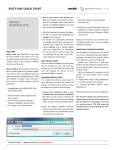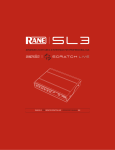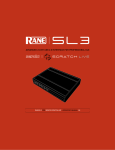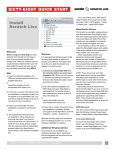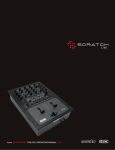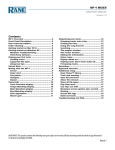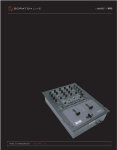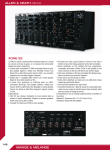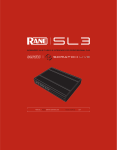Download Sixty-One Quick Start 2.4.2
Transcript
SIXTY-ONE QUICK START If you add a Rane device and need to install its ASIO driver, plug it into a USB, and select: Start > All Programs > Serato > Scratch Live > Install ASIO Drivers. Install Scratch Live Welcome Rane Device Drivers Before using your Sixty-One, at least read this short booklet for the basics, even if you are already familiar with Scratch Live. Read the complete manual to get the best investment from your new Sixty-One. Windows Mac 1. Connect your Sixty-One before you insert your installation CD. When you first connect it, Windows will attempt to install the drivers via the hardware wizard. Cancel and close the hardware wizard. 1. Insert the Software Installation CDROM and double-click the Scratch Live Installer.mpkg icon. or Launch the installer you just downloaded from serato.com. 2. Follow the on-screen instructions. Once the installation is complete, Scratch Live will appear in your applications list. You may like to drag the Scratch Live icon to your dock for quick launching. 3. Plug in your Sixty-One. No extra installation is required to use Scratch Live. 4. The optional Rane Device Drivers are required for other software you may have that uses Core Audio to communicate with your Rane device. To install the Core Audio drivers, doubleclick the .pkg file inside the appropriate product folder in the Rane Device Drivers folder on the software installation CD. It is important that Windows users install the Sixty-One drivers as well as the Scratch Live software. The easiest way to do this is to allow the Scratch Live installer to do all the work. 2. Insert the Software Installation CDROM. Make sure your Sixty-One is connected first. If a window doesn’t open automatically, browse to the CD drive. Run setup.exe. or Launch the installer you just downloaded from serato.com. The Scratch Live installer includes drivers that allow your Rane Sixty-One to work with other audio applications that support Core Audio (Mac) and ASIO (PC). Driver updates are also available to download from the product’s page at rane.com. Once installed, you have the option to select the Sixty-One’s inputs and outputs in the audio settings of other applications when Scratch Live is not open. When using Serato Scratch Live, proprietary Serato Audio Research drivers are used in place of Rane ASIO (Windows) and Core Audio (Mac) drivers. The included Rane drivers are used when Scratch Live is not running, and will not run the same time as Scratch Live. NOTE: These drivers only work with audio applications that are compatible with these audio standards (ie. some DAWs might not work with 64-bit drivers, you also can’t use these to output core Windows sounds). Rane ASIO and Core Audio drivers allow the Sixty-One to act as a 12-record 8-playback USB sound card for use with multiple third-party software applications supporting Core Audio or ASIO. These drivers are multi-client, meaning they allow multiple applications on a computer to share the device at the same time. 3. Follow the on-screen instructions. Once the installation is complete, Scratch Live appears in the Start Menu under All Programs > Serato > Scratch Live. ASIO (Windows) Because the Sixty-One was connected prior to installing Scratch Live, no extra hardware installation is required. Core Audio (Macintosh) Additional Windows Drivers The driver Control Panel may be launched from the Windows Control Panel. Select Start > Control Panel > Rane Sixty-One. To launch the Sixty-One driver Control Panel, open the System Preferences window. Locate Sixty-One in the “Other” section and click the Sixty-One icon. Once Scratch Live is installed, any additional hardware that is connected will be recognized and the drivers will be automatically installed. RANE SIXTY-ONE MIXER FOR FOR SERATO SCRATCH LIVE • QUICK START 1 Analog Outputs Connections This guide will help you get your decks connected and music playing. Turn the power off while connecting your decks and amplifiers. Analog Inputs 1. Connect your Left deck’s RCA cables to Analog Input 1. • If it’s a CD player, select CD with the switch above the input jacks. • If it’s a turntable, select PH (Phono) with the switch above the input jacks. Secure the ground wire to a Phono Ground terminal. 2. Set the SOURCE selector for PGM 1. THRU 1 plays directly from your deck. To play from the Left Virtual Deck in Scratch Live, choose 1. 3. Connect your Right deck’s RCA cables to Analog Input 3. • Select CD or PH as in step 1. 4. Set the SOURCE selector for PGM 2. THRU 3 plays directly from your deck. To play from the Right Virtual Deck in Scratch Live, choose 2. 2 •Main Out is on a pair of balanced ¼˝ TRS jacks. •Session Out is available on a pair of unbalanced RCA jacks. •Headphones output is available on both ¼˝ TRS and 3.5 mm jacks. The Main and Session outputs come from the same “Main Mix” signal. Main and Session outputs each have their own Level control. Because these signals are identical, you may use either of these outputs as the “Main” output if the other cable type is needed for the amplifier. Rane recommends balanced 1/4” TRS wiring for the strongest signal and rejection of hum and noise. If your cable to the destination is less than 10 feet (3 meters), you can often get away with an unbalanced cable. See the RaneNote “Sound System Interconnection” at rane. com for cable wiring recommendations. USB Control Source The default Inputs for decks performing Digital Vinyl Simulation (DVS) are Inputs 1 and 3, but you can change this. Analog Input 1 or 2 may be selected in Scratch Live software as the DVS signal for the Left Virtual Deck. Analog Input 3 or 4 may be selected in software as the DVS signal for the Right Virtual Deck. To select the control sources in Scratch Live, click the SETUP button at the top of the Scratch Live screen. In the Hardware > General tab, verify that Control Source > PGM 1 is set to “1”. This will be your Left Virtual Deck. verify that Control Source > PGM 2 is set to “3”. This will be your Right Virtual Deck. Calibrating Scratch Live Since Scratch Live is controlled by an analog signal, there is no guarantee of what state that signal will be in by the time the software gets to interpret it. Therefore, Scratch Live needs to be able to handle a wide range of signals, and be configurable to use them optimally. Calibrating is just configuring the software to your situation. Calibration is equally important for both vinyl and CD users of Scratch Live. There are two parts to the Scratch Live control signal: The directional tone, and the noise map. Listening to the control vinyl, the directional tone is the 1 kHz tone. The noise map sounds like random noise over the top of the tone. The directional tone provides the current speed and direction of the record, while the noise map tells the software precisely where on the record the needle is currently. The Noise Threshold A threshold is a lower limit, below which a process will not occur. In the case of Scratch Live, the noise threshold is the limit below which the input signal will not be interpreted as control signal; in other words if it’s below the threshold, it is considered noise and ignored. This setting is necessary because a stylus is very sensitive, and will inevitably pick up noise from the environment as well as the signal on the record, especially in the noisy environment of a live show. RANE SIXTY-ONE MIXER FOR SERATO SCRATCH LIVE • QUICK START How to Calibrate Scratch Live The Scopes With music playing in the background (from any source), put your needle on the record with the turntable stopped. If you are using CD players, the same rules apply. Have the CD deck paused or stopped while calibrating. Ensure the rear panel P - L - S switches are set correctly. Click and hold the estimate button until the slider stops moving. Moving the threshold slider to the left will make Scratch Live more sensitive to slow record movement, but also more sensitive to background noise. The scopes on the Setup screen in Scratch Live display the input signal as a phase diagram. The key factors to look at on the scope display are crisp clean lines, round shape, and the tracking percentage in the lower right corner. Start both turntables or CD players. You will see green rings appear in the scope view as shown above. For optimal performance the inner ring should be as close to circular as possible. Use the scope zoom slider (1x to 16x) to zoom in or out as necessary. Use the scope L/R Balance and P/A Balance controls to adjust the inner ring shape. The number in the top left corner of the scope view gives the current absolute position within the control record or CD. The number in the top right corner is the current speed in RPM. In the bottom left is the current threshold setting, and the number in the bottom right shows the percentage of readable signal — this number should be close to 85% when your system is calibrated properly. Repeat the process for each deck. Things to remember: •Your needle must be on the record. •Your turntable (or CD player) must be stationary. •The background music playing must be at a similar level to which you will play your set at. •Calibrate Scratch Live every time you play. TIP: If the slider jumps to the far right, then you have a problem with noise in your turntables/CD players/mixer. Check all your connections and make sure your equipment is well earthed. In some situations you will not be able to improve the signal quality, and you will have to play on regardless. In this situation, stick to REL mode. Calibration Troubleshooting After calibration, the number in the upper right corner of the scope view should say 0.0 while the needle is on the record and the turntable is stopped. If that number is fluctuating then manually move the Estimate slider to the right until that number is stable at 0.0. If you’ve moved the slider all the way RANE SIXTY-ONE MIXER FOR FOR SERATO SCRATCH LIVE • QUICK START to -24 and its still fluctuating then you have a grounding or interference problem somewhere in the chain. If so, the first thing to check is that the grounding wire coming from your turntable is connected to a Sixty-One grounding post. Next, make sure that the Sixty-One isn’t sitting next to a power source such as a power strip and that the RCA cables aren’t laying across other power conducting cables. If you are still experiencing issues, you might have to adjust the placement of your setup. For example, make sure bass bins aren’t directly under the turntables. If you have trouble getting the rings circular, you probably need to clean or change your needles. If the image appears as a line, then you have a missing channel. Check your RCA connections and needles. For more calibration troubleshooting help see “Scope Reading and Fixes” in the manual. More Help At serato.com/forum, thousands of tips are updated daily. You definitely want to bookmark this one in your browser. The Support Articles are another valuable read at serato.com/scratchlive/support. Over 70 topics including a Laptop Buying Guide, Your First Party with Scratch Live, Recording Your Set, and Moving Your Library and Crates to a New Computer or Hard Drive. 3 Keyboard Shortcuts KEY ctrl - L ctrl - R ctrl - F ctrl - A ctrl - C ctrl - E ctrl - V ctrl - X ctrl - Z shift - ctrl - shift - ctrl - ctrl - P ctrl - N ctrl - O - or + ctrl - or + tab ctrl - del and ctrl - backspace alt - del and alt - backspace ctrl - shift - del and ctrl - shift - backspace ctrl - shift - / esc SP-6 SAMPLE PLAYER Load to sample slot Play sample slot LEFT DECK ctrl - or shift - ctrl - shift - shift - alt - ctrl - , (comma) ctrl - 1, 2, 3, 4, 5 1, 2, 3, 4, 5 F1 F2 F3 F5 Q W E R T Y U I O P [ ctrl - [ alt - Q alt - W alt - 1, 2, 3, 4, 5 ctrl - alt - 1, 2, 3, 4, 5 alt - E alt - R alt - O alt - L alt - space bar ctrl - I Actions Accessed Directly from the Computer Keyboard ACTION Locate the current track. This will highlight the track you most recently loaded. Pressing ctrl - L again will alternate between the tracks recently loaded on both decks. Reveal - the highlighted song is opened in a file browser. Find - moves the cursor to the search box. Select all. Copy text in edit mode. Edit text. Paste text in edit mode. Cut text in edit mode. Undo last track load. Move focus up / down through the library or crates. Note that if you have a song highlighted in the song view, and use shift - ctrl - you will move up or down through the library or crates. When you release the shift or ctrl key, the focus will go back to the song view so that you can move up and down through songs using . Add tracks to the prepare window. Start a new mic recording. Open the track in your default MP3/WAV/OGG/AIF player. Zoom the main waveform display. Zoom the library text size. Alternate focus between crates or songs. Remove track from library., remove track from crate, delete crate (does not delete the file). Remove track from crate and from library. Delete the file from your library and send to the recycle bin. (Note to iTunes users: files in your iTunes library cannot be deleted this way). Toggle the input reverse switch Clear search string if searching, or exit Scratch Live. slot 1 slot 2 slot 3 slot 4 slot 5 slot 6 ctrl - alt - Z ctrl - alt - X ctrl - alt - C ctrl - alt - V ctrl - alt - B ctrl - alt - N Z X C V B N ACTION Load the highlighted song to a deck. Load the track currently on one deck onto the other deck as well (instant doubles). Unload the track from a deck. Place a cue point. Place a cue point in a slot. Jump to cue points slots. (rel and int modes) Switch deck to absolute mode. Switch deck to relative mode. Switch deck to internal mode. Key lock on / off. Play / pause reverse. Play / pause forward. Pitch down. Pitch up. Bend down. (rel and int modes) Bend up. (rel and int modes) Censor. (rel and int modes) Go to temporary cue point. (rel and int modes) Set / adjust loop in-point. Set / adjust loop out-point. Loop on / off. Jump to selected loop. Load previous track. Load next track. Auto loop on / off. Loop roll. Rewind. (rel and int modes) Fast forward. (rel and int modes) Previous loop. Next loop. Activate the tempo tapper. Set temporary cue point. (rel and int modes) RIGHT DECK ctrl - or shift - ctrl - shift - shift - alt - ctrl - . (period) ctrl - 6, 7, 8, 9, 0 6, 7, 8, 9, 0 F6 F7 F8 F10 A S D F G H J K L ; ' ctrl - ' alt - A alt - S alt - 6, 7, 8, 9, 0 ctrl - alt - 6, 7, 8, 9, 0 alt - D alt - F alt - P alt - ; alt - space bar (x2) ctrl - K RANE SIXTY-ONE MIXER FOR SERATO SCRATCH LIVE • QUICK START • PART 21323




